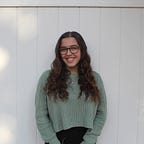Radio Show Script
-Hi my name is Gina Pepe and I am a sophomore Biology major here at Siena College. Today I will be exploring the form of concrete poetry. Described by Mary Ellen Solt in “Concrete Poetry: A World View”, concrete poetry can fall under three categories: visual or optic, phonetic or sound , or kinetic or moving in a visual succession. Solt says “ The constructivist poem results from an arrangement of materials according to a scheme or system set up by the poet which must be adhered to on its own terms” This type of poetry is very different from many other forms because it is up to the poet to make the major decisions regarding how the poem is presented. Typical forms of poetry follow a set number of lines, or stanzas, a rhyming pattern, or even a syllabic pattern. For example a Haiku poem follows a strict 5,7,5 syllable pattern, or a Pantoum follows a pattern of the same lines repeating throughout the poem. In a concrete poem, it is more focused on how the reader can perceive the poem as an object that the poet is attempting to create. When the poet is not confined to a specific structure, the opportunities for topics are endless, as inspiration can truly come from anywhere. When there is a large degree of freedom in one’s writing, it may be difficult to still create an impactful poem. I and some would agree that something wonderful about poetry is that it uses so little words to create so many meanings. When the poem has potential to continue on and on, it may lose that sense of mystery and interpretation that short poems can have. However, this is not the case for all longer poems, in fact, the poem we will be discussing today benefits from its length.
- As a biology student, I am always looking for scientific applications in poems, especially more contemporary works, and our special guest did just that. Today we will be diving into the book “Cutting Time with A Knife” written by Michael Leong which is “part long poem, part science fiction manifesto” I took particular interest into this book as it was completely different from any other poem I have ever read, because one, it is based on the periodic table of elements and it almost seemed like two poems in one. This book is formatted in a very interesting manner where there is an element of the periodic table on each page and a short piece of a long form poem on the bottom of the page. Why don’t we dive a little further into this book? I am so happy to be joined by Michael today to learn some more about this piece.
-Hi Michael, how are you today?
-Well I am so happy you are able to speak with me today to talk about this amazing book.
-I started talking about the format and style on the page, which is very interesting. Each element was placed at the top of the page in the box that you would traditionally see on the periodic table, with the long form poem underneath that. How did you come up with it?
-Continuing on with how you formatted the book, there are little pictures that appear on some of the pages? What do they mean?
Order of questions to ask
- Each element was placed at the top of the page in the box that you would traditionally see on the periodic table, with the long form poem underneath that. How did you come up with it?
- Continuing on with how you formatted the book, there are little pictures that appear on some of the pages? What do they mean?
- The introduction of your book mentions some inspirations coming from a quote by William S. Burroughs that read “If you cut into the present the future leaks out” How did you use this as maybe the inspiration or basis for your book?
- Before the book begins you quoted T.S. Elliot’s “Tradition and the Individual Talent” saying “The mind of the poet is a shred of platinum” I noticed that this was the format that you continued on with all of the elements. Can you talk more about how you used this to create all of the other elements?
- Since this book was not exactly a traditional style of poetry, can you describe the process of making your own form? How did it come together?
- After reading, it almost seemed like it was two poems in one, the element poems and then the continuing poem from page to page. How were you able to connect the “elements” of the poem to the parts of the physical body and then connect them to the “long poem”?
- For the poem that flowed with just the elements, I noticed that they are all related to human body parts or emotions, did you have a specific reason for the order they were placed in?
- Most of the pages that contain the long form poem are in one font, but Pages 84–88, Elements Po-Ra (Polonium to Radium) are in a different font. Why?
- Lastly and just for fun, do you have a favorite element or element poem that you wrote? If so, why was this your favorite?
Well, Michael, Thank you so much for joining us and helping us further understand your amazing book, it was so great getting to talk to you. If anyone listening would like to check out his book, or learn more about the concrete poetic form, check out my blog at (add link).
“The mind of the poet is a shred of platinum” TS Elliot
